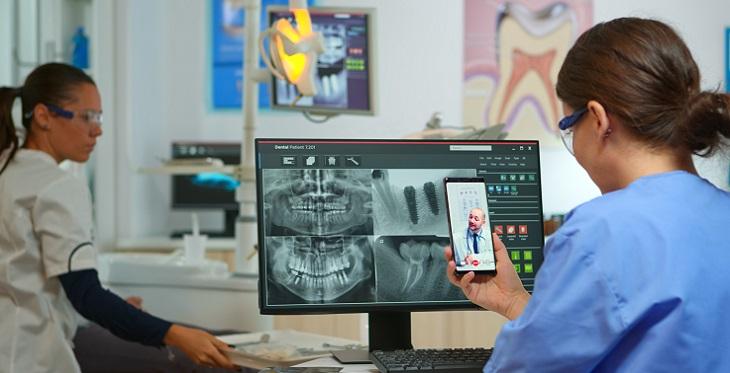
Well… not quite; but it may not be what you think.
I’m not here to make the case about the importance of good oral health, the impacts of poor oral health on overall health and chronic disease, the potential to lower health care costs and our countless opportunities to integrate oral health into health care services. Rather I ask that you join me to learn just a bit more about what teledentistry is and how it can be used to expand access, provide education and elevate team-based care.
Teledentistry. The American Dental Association (ADA) Policy on Teledentistry notes that services delivered via teledentistry must be consistent with how they would be delivered in-person. According to the ADA, teledentistry includes patient care and patient education delivery using (but not limited to) four modalities:
- Synchronous (live video) – use of audio and video for real-time communication
- Asynchronous (store and forward) – secure electronic transmission of radiographs, photos, video, digital impressions or photomicrographs, etc. to evaluate, render an opinion or service or develop a treatment plan
- Remote physiologic monitoring – electronic transmission of physiologic data (e.g., weight, oxygen saturation, blood glucose levels)
- Mobile health (mHealth) – sharing of education and/or information by mobile communications or use of apps (e.g., reminds or monitors oral hygiene activities)
Store and forward. Dental hygienists can assess the mouths of patients, chart areas of concern, decay or periodontal disease, take high-resolution photographs and x-rays and transmit that information to a dentist who can review the materials and develop a treatment plan for a patient.
Expand access. In rural areas with shortages of dentists, primary care clinics can “bring” a dentist or other oral health specialist into the exam room by synchronous (live video) communication to assess and discuss a dental issue and subsequent treatment plan for a patient. This is a far superior option than just prescribing antibiotics and pain medications, which may end with the patient in the emergency department.
Education. Using a synchronous modality, there are ample opportunities for providing oral health education to patients and families, those in dentistry, those in the medical field, teams considering oral health integration and more.
While there are several teledentistry modalities available, the following are the high leverage applications:
- Using store and forward technology for dental hygienists and others on dental and medical care teams
- Including dentists and other oral health and dental specialists (e.g., orthodontist) to join primary care office visits
- Using synchronous and asynchronous (e.g., secure messaging/email) options for provider-to-provider consults
- Providing synchronous and broad oral health education
What’s in it for us and ours? How do we harness teledentistry to improve oral health?
As an individual, it’s reasonable to ask your dentist what they are doing or are planning to do to implement or expand teledentistry to know whether there are additional options for you. If delivering health care services to patients, whether in the outpatient, inpatient, specialist, long-term service supports or elsewhere, we should:
- Know what the teledentistry options are in our area, especially if we are in a rural area with a shortage of dentists
- Ensure that all patients have a dental home and are receiving preventive and curative dental services – by teledentistry if necessary and available to them
- Consider an oral health education program that is delivered virtually or remotely and/or includes mHealth or app-based options
If you are particularly passionate about the potential of teledentistry, know the barriers in your state and area and find ways to overcome those barriers, which include parity of coverage, parity of payment, and statutes governing teledentistry in your state. Checking this interactive map from the Center for Connected Health Policy is a good starting place. Adequate and access to bandwidth and provider, patient and family buy-in can be significant factors as well.
Either way – let’s get our teeth into teledentistry and do what we can to leverage the full range of options to help individuals optimize their oral health.


